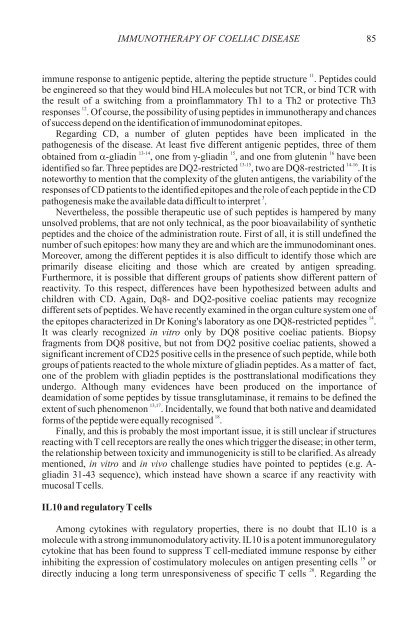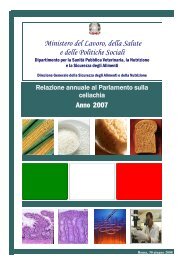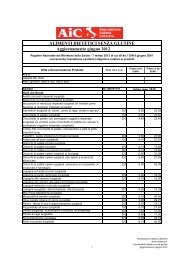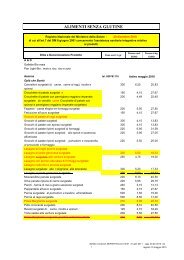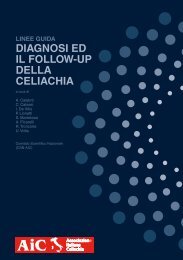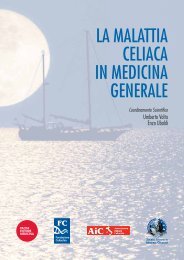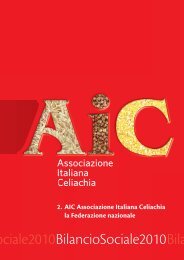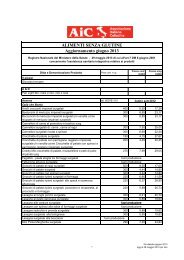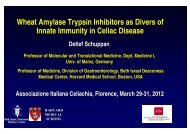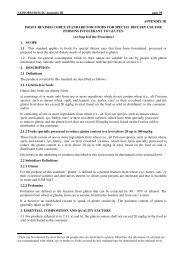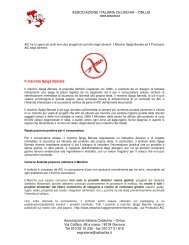primary prevention of coeliac disease - Associazione Italiana ...
primary prevention of coeliac disease - Associazione Italiana ...
primary prevention of coeliac disease - Associazione Italiana ...
You also want an ePaper? Increase the reach of your titles
YUMPU automatically turns print PDFs into web optimized ePapers that Google loves.
IMMUNOTHERAPY OF COELIAC DISEASE<br />
85<br />
11<br />
immune response to antigenic peptide, altering the peptide structure . Peptides could<br />
be enginereed so that they would bind HLA molecules but not TCR, or bind TCR with<br />
the result <strong>of</strong> a switching from a proinflammatory Th1 to a Th2 or protective Th3<br />
12<br />
responses . Of course, the possibility <strong>of</strong> using peptides in immunotherapy and chances<br />
<strong>of</strong> success depend on the identification <strong>of</strong> immunodominat epitopes.<br />
Regarding CD, a number <strong>of</strong> gluten peptides have been implicated in the<br />
pathogenesis <strong>of</strong> the <strong>disease</strong>. At least five different antigenic peptides, three <strong>of</strong> them<br />
13-14 15 16<br />
obtained from a-gliadin , one from g-gliadin , and one from glutenin have been<br />
13-15 14-16<br />
identified so far. Three peptides are DQ2-restricted , two are DQ8-restricted . It is<br />
noteworthy to mention that the complexity <strong>of</strong> the gluten antigens, the variability <strong>of</strong> the<br />
responses <strong>of</strong> CD patients to the identified epitopes and the role <strong>of</strong> each peptide in the CD<br />
3<br />
pathogenesis make the available data difficult to interpret .<br />
Nevertheless, the possible therapeutic use <strong>of</strong> such peptides is hampered by many<br />
unsolved problems, that are not only technical, as the poor bioavailability <strong>of</strong> synthetic<br />
peptides and the choice <strong>of</strong> the administration route. First <strong>of</strong> all, it is still undefined the<br />
number <strong>of</strong> such epitopes: how many they are and which are the immunodominant ones.<br />
Moreover, among the different peptides it is also difficult to identify those which are<br />
primarily <strong>disease</strong> eliciting and those which are created by antigen spreading.<br />
Furthermore, it is possible that different groups <strong>of</strong> patients show different pattern <strong>of</strong><br />
reactivity. To this respect, differences have been hypothesized between adults and<br />
children with CD. Again, Dq8- and DQ2-positive <strong>coeliac</strong> patients may recognize<br />
different sets <strong>of</strong> peptides. We have recently examined in the organ culture system one <strong>of</strong><br />
14<br />
the epitopes characterized in Dr Koning's laboratory as one DQ8-restricted peptides .<br />
It was clearly recognized in vitro only by DQ8 positive <strong>coeliac</strong> patients. Biopsy<br />
fragments from DQ8 positive, but not from DQ2 positive <strong>coeliac</strong> patients, showed a<br />
significant increment <strong>of</strong> CD25 positive cells in the presence <strong>of</strong> such peptide, while both<br />
groups <strong>of</strong> patients reacted to the whole mixture <strong>of</strong> gliadin peptides. As a matter <strong>of</strong> fact,<br />
one <strong>of</strong> the problem with gliadin peptides is the posttranslational modifications they<br />
undergo. Although many evidences have been produced on the importance <strong>of</strong><br />
deamidation <strong>of</strong> some peptides by tissue transglutaminase, it remains to be defined the<br />
13,17<br />
extent <strong>of</strong> such phenomenon . Incidentally, we found that both native and deamidated<br />
18<br />
forms <strong>of</strong> the peptide were equally recognised .<br />
Finally, and this is probably the most important issue, it is still unclear if structures<br />
reacting with T cell receptors are really the ones which trigger the <strong>disease</strong>; in other term,<br />
the relationship between toxicity and immunogenicity is still to be clarified. As already<br />
mentioned, in vitro and in vivo challenge studies have pointed to peptides (e.g. A-<br />
gliadin 31-43 sequence), which instead have shown a scarce if any reactivity with<br />
mucosal T cells.<br />
IL10 and regulatory T cells<br />
Among cytokines with regulatory properties, there is no doubt that IL10 is a<br />
molecule with a strong immunomodulatory activity. IL10 is a potent immunoregulatory<br />
cytokine that has been found to suppress T cell-mediated immune response by either<br />
19<br />
inhibiting the expression <strong>of</strong> costimulatory molecules on antigen presenting cells or<br />
20<br />
directly inducing a long term unresponsiveness <strong>of</strong> specific T cells . Regarding the


